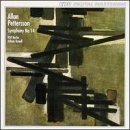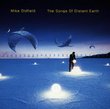| All Artists: Allan Pettersson, Johan M. Arnell, Berlin Radio Symphony Orchestra Title: Allan Pettersson: Syphony No. 14 Members Wishing: 1 Total Copies: 0 Label: Cpo Records Release Date: 1/25/1995 Genre: Classical Styles: Historical Periods, Modern, 20th, & 21st Century, Symphonies Number of Discs: 1 SwapaCD Credits: 1 UPC: 761203919123 |
Search - Allan Pettersson, Johan M. Arnell, Berlin Radio Symphony Orchestra :: Allan Pettersson: Syphony No. 14
 | Allan Pettersson, Johan M. Arnell, Berlin Radio Symphony Orchestra Allan Pettersson: Syphony No. 14 Genre: Classical
|
Larger Image |
CD DetailsSimilarly Requested CDs
|
CD ReviewsIntense and frightening like nothing else Russ | Richmond, VA | 10/13/2007 (5 out of 5 stars) "How can one really describe the music of Allan Pettersson (1911-1980)? Well, it is truly like nothing else. Pettersson's gargantuan symphonies are products of the Romantic tradition, yet Pettersson's music is among the most radical of the twentieth century. But let me be clear that Pettersson's radicalism is unrelated to experiments with serialism or the use of unconventional orchestration. Pettersson was not involved with such things. In fact, his music is based upon simple, tonal melodic fragments, which when weaved together create the canvases for his symphonies. Rather, Pettersson's radicalism manifests itself in the form of extreme emotionality. That is, this is angry, bleak music, with nary a ray of sunshine to be found. And such is the case with Pettersson's Symphony No. 14 (1978). If anything, this work is grimmer than the typical Pettersson symphony. Certain of Pettersson's other symphonies (ex. Symphony No. 7) contain lyrical sanctuaries of relative calm amidst a harsh landscape of fury. This type of reprieve is not present in the fourteenth. Here, Pettersson expresses himself through angry, dissonant orchestral outbursts underpinned by harsh ostinatos (the forceful climax beginning at 27:55 is among the scariest within Pettersson's symphonies). But there are also moments of frightening fragility (ex. 3-minute mark), in which a permeating feeling hopelessness and dread prevails. Like most of Pettersson's other symphonies, the fourteenth is cast in a single movement. There really isn't any form here - at least, not that I can detect. The music proceeds purposefully, but the turns it takes are often unexpected. Perhaps the most unexpected turn is the work's concluding C major chord - the only recognizable major chord in the symphony by my reckoning. This will probably be the only instance in which I describe a C major conclusion as chilling. Of course, repeated listenings of this work are recommended; however I think most listeners will be able to sense the anguish and rage present in this symphony during a first hearing. It is difficult for me to say where this symphony ranks among Pettersson's other symphonies. I suspect classical music listeners will either want nothing to do with Pettersson, or want to acquire the complete symphonic cycle. So, if you are gradually sampling through this cycle, I would pick up the seventh, eighth, eleventh and ninth before venturing to the fourteenth. The RSO Berlin performs this music well, and CPO's engineering of this 1988 recording is quite good. You will probably know if you are destined to become a Pettersson fan after a couple of listenings to one of his symphonies. If you have not really sat down with one of Pettersson's symphonies, you probably owe it to yourself to do so. While not for everyone, it is undeniable that this is amazing music. Highly recommended. TT: 47:00" Don't Make This Your First Pettersson Giordano Bruno | Wherever I am, I am. | 07/20/2008 (4 out of 5 stars) "This one-movement 47-minute symphony of despair is a difficult work to enjoy and an impossible work to recommend to anyone who doesn't already have some regard for the music of Allan Pettersson. It is certainly masterful in compositional technique, a twisted and knotted hawser of orchestral heterophony stretched taut from beginning to end. I've listened to it straight through and in segments, and I've found my attention strained by the former. Of all Pettersson's 16 symphonies, it's the only one I can't wax enthusiastic about. Frankly, the emotions it echoes are not mine and I don't covet them. If you want to scale the craggy face of Swedish's most formidable modern composer, try Symphony #6 or #16 first.
The one previous review is more ample and more laudatory. I urge you to read it also." |

 Track Listings (1) - Disc #1
Track Listings (1) - Disc #1




![Seussical [2000 Original Broadway Cast]](https://nationalbookswap.com/cd//m/02/4802/514802.jpg)



